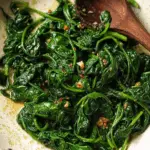The Crispy Salt and Pepper Squid is the ultimate snack or appetizer that combines irresistibly tender squid with an ultra-crunchy, golden crust. Thanks to a carefully balanced mix of flour and cornflour, plus a chilled batter technique, each bite delivers a satisfying crunch without any greasiness.
Perfectly seasoned with white pepper and salt, this dish is made even better with a side of garlic aioli or a fresh squeeze of lemon. It’s a restaurant-quality dish that’s surprisingly simple to recreate at home. Whether you’re entertaining guests or just treating yourself, this crispy squid is guaranteed to impress.
Full Recipe:
-
700g (1.4 lb) whole baby squid (or 500g / 1 lb cleaned squid tubes)
-
2/3 cup cornflour (cornstarch)
-
1/3 cup all-purpose flour
-
1/2 tsp baking powder
-
1/2 tsp kosher salt
-
1/4 tsp white pepper powder
-
2/3 cup cold tap water
-
3–4 cups vegetable or canola oil (for deep frying)
-
Extra salt and white pepper for seasoning
-
Lemon wedges or garlic aioli for serving
Directions:
-
Clean and prepare the squid: Cut the tubes open and score the inside with shallow diamond cuts. Slice into roughly 5 x 2 cm pieces. Pat dry.
-
In a bowl, mix the cornflour, flour, baking powder, salt, and pepper. Gradually whisk in water until smooth.
-
Refrigerate batter for 30 minutes to let gluten develop for optimal texture.
-
Heat oil to 160°C/320°F in a heavy pot.
-
Add all squid pieces to the chilled batter. Coat well.
-
Fry in 3 batches for 2 minutes (baby squid) or 3 minutes (squid tubes) until light golden. Remove to paper towels.
-
Increase oil heat to 200°C/390°F. Fry all squid in 2 batches for 90 seconds each until deeply golden and crispy.
-
Drain on paper towels, then season lightly with salt and pepper.
-
Serve hot with garlic aioli or lemon wedges.
Prep Time: 15 minutes | Cooking Time: 15 minutes | Total Time: 30 minutes (plus 30 minutes batter chilling)
Kcal: Approximate, varies due to frying oil | Servings: 4 as a main, up to 8 as a starter
A Deep Dive into the Crispy Salt and Pepper Squid Sensation
Crispy Salt and Pepper Squid is one of those unforgettable dishes that manages to blur the line between indulgent snack and elegant appetizer. Known for its unmistakable crunch and tender squid interior, this dish has made its way from humble Asian street food origins into the hearts—and menus—of global kitchens. The irresistible contrast of textures, the subtle heat from white pepper, and the light, savory batter all play a role in making this dish an unforgettable culinary experience.
Unlike many deep-fried dishes that lose their appeal as they cool down, the version we’re discussing today holds its crunch remarkably well, even after it’s gone cold. That’s not just luck—it’s the result of careful culinary science and refined technique. This is what sets it apart from the greasy, soggy versions that have disappointed diners for far too long.
What Makes It So Unique?
At the heart of this recipe lies a batter that took over three years of experimentation and refinement to perfect. The creators weren’t satisfied with good enough. They were on a mission to engineer a squid dish so crispy, so golden, and so consistently tender that it would outperform any restaurant version. And they succeeded.
The batter uses a calculated blend of plain flour and cornflour to balance texture and color. Cornflour is known for giving food a light, crispy texture but doesn’t brown as well, while plain flour adds a beautiful golden hue and structure but lacks crispness. When used in the right ratio, they work together to form a light yet shatteringly crisp crust that adheres well to the squid.
Another key innovation in this recipe is the refrigeration of the batter for 30 minutes. This step allows the gluten in the flour to develop and relax, creating a batter that clings better to the slippery squid surface. It also chills the mixture so that when it hits the hot oil, it shocks into crispness almost instantly. This step alone elevates the dish beyond the ordinary.
Double Frying: The Crispy Secret Weapon
One of the most impactful techniques used in this recipe is double frying. While the first fry cooks the squid and sets the batter, the second fry—at a higher temperature—transforms the exterior into an ultra-crispy shell. It’s a method borrowed from traditional Asian kitchens and is one of the worst-kept secrets among professional chefs for creating irresistibly crispy foods.
By frying the squid initially at a lower temperature and then finishing it at a much higher one, the outer layer becomes more stable and less likely to absorb oil. This ensures the final product is crispy without being greasy—a common pitfall in lesser versions of this dish.
Texture: The Perfect Contrast
The textural contrast in this dish is what makes it so addictive. The outside is audibly crispy, shattering between your teeth, while the inside remains tender and juicy. This is thanks to the quick cooking time and the small size of the squid pieces. Cooking squid for too long turns it rubbery and unpleasant, but a short, high-heat fry locks in moisture and tenderness.
The addition of lightly scored squid before cutting it into bite-sized pieces adds another layer of sophistication. The scoring not only helps with even cooking but also increases surface area, allowing more batter to cling to the squid—meaning more crunch per bite.
Flavor Profile: A Subtle, Sophisticated Punch
This recipe doesn’t overwhelm the natural flavor of the squid. Instead, it enhances it with just a few well-placed ingredients. The use of white pepper instead of black pepper adds a floral heat that lingers gently on the palate. Combined with just a touch of salt, the seasoning respects the squid while elevating its oceanic sweetness.
The dish is traditionally served with a garlic aioli or a wedge of lemon. Both options work beautifully to cut through the richness of the fried batter and add a bright, fresh dimension to each bite. Aioli offers creamy decadence, while lemon provides a zesty punch. The choice depends on the experience you want—comfort or brightness.
Cultural Context and Culinary Evolution
Salt and Pepper Squid has strong roots in Chinese cuisine but has since become a globally loved dish. You’ll find versions of it in Vietnamese, Thai, and even Italian restaurants—each with their own unique twist. The version featured here takes inspiration from classic Chinese cooking but adds a contemporary spin through improved technique and ingredient refinement.
This evolution mirrors the broader trend in home cooking today—moving from merely replicating restaurant dishes to improving upon them. It reflects a deeper understanding of food science and technique, something that home cooks are increasingly embracing.
Why It’s Perfect for Home Cooks
Despite sounding complex, this recipe is surprisingly accessible. The batter ingredients are pantry staples, the squid can be sourced pre-cleaned from most fishmongers, and the cooking process is straightforward with a little practice. The use of common equipment like a heavy pot and a thermometer makes it achievable in an everyday kitchen setting.
Moreover, it’s a dish that scales easily. You can make a small batch for a cozy night in or a large platter for entertaining. Its versatility as a snack, appetizer, or even a light main course makes it a go-to option for various occasions.
Reheating and Leftovers
Amazingly, this squid maintains its crispiness even when cold. Reheating it in a hot oven for just a few minutes revives the crunchy texture without compromising the squid’s tenderness. This makes it one of the few fried dishes that tastes just as good the next day, opening up the door to meal prepping or make-ahead entertaining.
Whether you’re serving it fresh or reheating it, the dish holds its integrity—another testament to how well-engineered this recipe truly is.
Health and Nutritional Thoughts
While this isn’t exactly a diet food—it’s fried, after all—it’s far less greasy than many other fried options due to its quick fry time and double-fry technique. There’s also a certain satisfaction in knowing exactly what’s going into your dish when you make it yourself. You control the oil quality, the seasoning, and the freshness of the seafood.
Adding a fresh side salad or steamed greens can help balance out the meal nutritionally, making it feel more wholesome while still indulgent.
Conclusion: A Modern Classic Worth Mastering
Crispy Salt and Pepper Squid isn’t just another deep-fried dish—it’s a culinary triumph of technique, texture, and taste. From the carefully calibrated batter to the double-fry method and thoughtful seasoning, each element works in harmony to produce a dish that’s as enjoyable to eat as it is to make.
This is more than just a recipe—it’s a lesson in how attention to detail and a passion for food science can turn a simple ingredient like squid into a star dish. Whether you’re hosting friends, treating your family, or simply indulging in a solo seafood moment, mastering this recipe will bring restaurant-level results to your home kitchen.
Try it once, and it might just become your signature dish.






